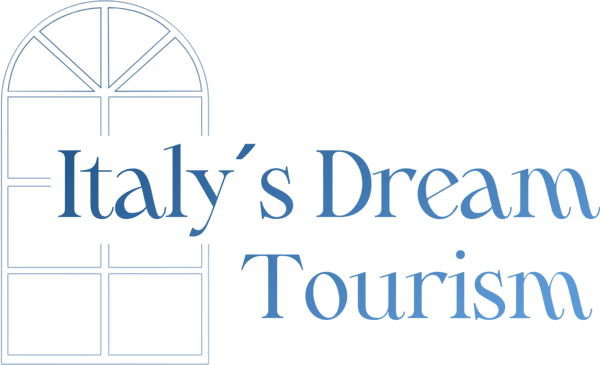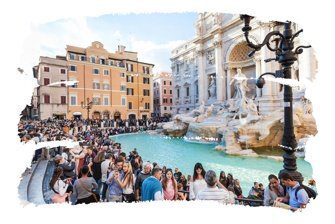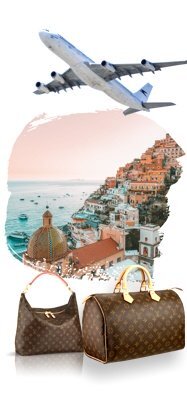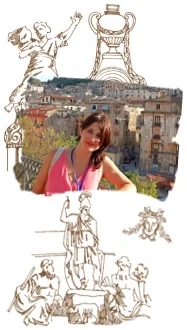Who are the main Italian artists?
When we talk about art some of the first names that come to mind are Italians! With this honor, of being the birthplace of some of the main artists in the world, Italy has become a reference for lovers of world art. Today we are going to talk about three exquisite artists: Leonardo Da Vinci, Michelangelo and Caravaggio. Let’s get to our post of the day: Who are the main Italian artists? Here at Your Travel to Italy with Ana Patricia you make the trip of your dreams!!! ALSO: see our “Accommodation in Italy – Tips for your holidays!”
Introduction
In Italy, in all cities, in all squares, churches and monuments, there is at least ONE work of art! Being an open-air museum, Italy has become a reference for various artistic periods with works of all sizes, charms and singularities! Talking about all the Italian artists and their main works would be something eternal, given the number of names that would deserve to be mentioned, but today we are going to talk a little about three artists that deserve to be highlighted for their magnanimous works: Leonardo Da Vinci, Michelangelo and Caravaggio.
1) Who are the main Italian artists? MEET LEONARDO DA VINCI
Leonardo di Ser Piero da Vinci was born on April 15, 1452 in the city of Vinci, in the region of Florence. He was the illegitimate son of Ser Piero, a wealthy landowner, and Catarine, a peasant woman. The surname Da Vinci was adopted in honor of his hometown. Leonardo was: scientist, mathematician, engineer, inventor, anatomist, painter, sculptor, architect, botanist, poet and musician; also considered one of the most important names of the High Renaissance, he had great prominence in aviation and ballistics. He lived in Milan, Venice and Rome and in 1516 he was invited by the French sovereign Francis I, to live in the Clous Castle, in France.
His Artistic Skills
His artistic skills were already noticed by his father, who gathered some of his son’s works and sent them to the workshop of Andrea del Verrocchio, who was an important name in the area of arts in the region at that time. Leonardo, then 14, was accepted into Verrocchio’s workshop and became his apprentice. At the age of 20, he became part of the Florence Painters’ Corporation and already had admiration, acceptance and respect from several artists and intellectuals. Leonardo learned, during the years of work, techniques of foundry, painting, writing and calculations as well as, he perfected himself in the use of colors and perspectives to execute fantastic works of art. He was one of the pioneers who wanted to unravel the mysteries of the human body and its forms and functioning; he studied fetuses in the womb, shapes of the human body, and dissected corpses. He also ‘invented’ the technique of writing from right to left, so that his notes could be read only with the help of a mirror.
The ‘Sfumato’ Painting Technique
The ‘sfumato’ painting technique, which consists of merging the colors without knowing where the outline of the paintings begins or ends, was created by him. A characteristic of Da Vinci is that he refused to deliver any order without it being PERFECT … For him! In the area of inventions, he created hundreds of projects in hydraulics, cosmology, geology, mechanics, music and daring engineering projects. Although few of his inventions have come out of the paper, his ideas have clearly contributed to science.
His Most Famous Works
His most famous works are Mona Lisa, or Gioconda (1503-1505), where he used the ‘sfumato’ technique and, today, is permanently exposed in the Louvre Museum, in Paris, and The Last Supper (1495-1497), a mural that shows Christ and his apostles, commissioned by the Church of Santa Maria delle Grazie in Milan (and which can be visited, click here to learn more). Leonardo never signed his works, so many of his works are lost; another fact: several works of his are unfinished. Pope Leo X spoke of Da Vinci: ‘He likes the path more than the arrival, more the process than the result.’
His death
The artist died on May 2nd, 1519 of natural causes. His body was buried in the Chapel of San Humberto, in the Castle of Amboise and on August 12th, 1519, his remains were buried in the cloister of the Church of San Florentino in Amboise. Curiosities: Da Vinci was left-handed, homosexual and vegetarian.
Useful information
TO VISIT AND GO DEEPER: There are two museums dedicated to Leonardo Da Vinci, one is in Rome and was recently opened. It presents the artist’s machines, notes and manuscripts; The other is in Florence and is a type of complex, where Leonardo’s house and some of his notes, works and inventions are also located.
- Leonardo Da Vinci Experience Museum – Address: Via della Conciliazione, 19 – Roma.
- Museo di Leonardo – Address: Via dei Servi, 66 / r – Florence.
2) Who are the main Italian artists? MEET MICHELANGELO
Michelangelo de Lodovico Buonarroti was a painter, sculptor, architect and poet. Being one of the greatest representatives of the Italian Renaissance, he is responsible for works such as Pietá, The Last Judgment, Moses, David and the famous Vault of the Sistine Chapel. Michelangelo was born in Caprese, in the province of Arezzo, on March 6th, 1475. Son of Lodovico Buonarroti and Francesca; since he was a kid, he just wanted to draw.
His Trajectory
At the age of 13, he began his studies at the workshop of the brothers Domenico and Davi Ghirlandaio, in Florence; in 1489 he was invited by Lourenço to study at the Medici Gardens Accademy and in 1492, at the age of just 17, he completed his first sculpture, ‘Madonna of the Stairs’. In 1497, French cardinal Jean Bilheres commissioned a marble sculpture from Michelangelo for his chapel in St. Peter’s Basilica. He was sent to Carrara to choose the best marble in a single block and thus Pietà was born, which was completed in 1499. It is undoubtedly the work that Michelangelo was most proud to have done, so much so that he made a point of signing in the strip that passes about the bust of Mary. This beauty can be seen in St. Peter’s Basilica, in the Vatican.
The Sistine Chapel at St. Peter’s Cathedral
In 1505, he was chosen to sculpt Pope Julius II’s funeral monument. The work took 40 years to be completed and its main highlight is the statue of Moses, which is 2.35 m high and is in the center of the lower part of the monument. The work of art is in the Basilica of San Pedro in Vincoli, in Rome. Michelangelo reluctantly made one of the most famous paintings in the world: the vault of the Sistine Chapel in St. Peter’s Cathedral, in the Vatican. When he was assigned to do the painting, he justified: ‘I am not a painter, I am a sculptor!’, Even so he committed himself to the project and delivered the work in 1512, on All Saints’ Day. The work took 4 years to complete and among the frescoes are ‘The Creation of Adam’, ‘Original Sin’, ‘The Expulsion from Paradise’ and ‘Great Flood’.
The Last Judgement
In 1534, Pope Clement VII commissioned the ‘Last Judgment’ for the altar in the Sistine Chapel. In the famous painting, Christ appears as an adamant judge and the Virgin, frightened, does not contemplate the scene. Due to the large number of nudes that appear in the painting, at the time the work caused a furor and Pope Paul III wanted to destroy it, however he asked Daniel from Volterra to “cover” the most daring nudes. Michelangelo died on February 18, 1564 and his body is buried in the Basilica of Santa Croce, in Florence.
Curiosities
- Michelangelo was bisexual, his nickname in the art world was ‘Divino’ and his father was against his artistic background.
- The Villa where Michelangelo lived, in Chianti, Tuscany, was recently put up for sale for 30 million BRL! The site is 13,000 m² in size and was purchased by the artist in 1549, while he was still working on the design of St. Peter’s Basilica in the Vatican. The house has three floors, ten bedrooms, seven bathrooms and remained in the hands of the artist’s family for 300 years before returning to the market. As it has become a private property, unfortunately it is not possible to visit it.
3) Who are the main Italian artists? MEET CARAVAGGIO
If I ask you what you think of the works of Michelangelo Merisi (or Amerighi), you probably won’t know who I’m talking about! Known as Caravaggio, in honor of his hometown, Caravaggio, the artist was born on September 29th, 1571 and was the son of Fermo Merisi, chief butler of Francesco Sforza, the Marquis of Caravaggio, and Lucia Anatore.
His Trajectory
Caravaggio was only six years old when the bubonic plague killed his father, and it is said that he grew up contentious and aggressive because of this. At the age of 12, in 1584, he entered as an apprentice in Simone Peterzano’s studio. There is no record of this phase of his life, however, it is known that he lost his mother in 1590. With the inheritance he received, Caravaggio left for Rome and lived there with artists and architects from all over the national and international art scene. He could have lived for several years on his inheritance money, but it is said that he spent it all too quickly, and in his early days in Rome, he had to fight against hunger and misery.
With his health broken, he was admitted to the Santa Maria della Consolazione Hospital, where he painted pictures for the institution. When he was discharged, he went to look for a job. Nobody hired him and the few who accepted him, soon dismissed him for his unique style and, for the time, outside the ‘artistic standards’. A little later, Cardinal Del Monte, a rich and sophisticated cleric who collected works of art, invited him to the Academy of Saint Luke, the school of painters in Rome. The cardinal took Caravaggio into his home and, in return, Caravaggio painted a series of pictures of effeminate young people, since Del Monte was ‘discreetly’ amusing himself with boys.
Controversial about his life
One of the artist’s polemics falls on Lena, a prostitute he said he used as a model to portray the Virgin. Violent, he got involved in several fights and ‘conquered’ several enemies over the years. The artist’s works gained prominence because of his ‘inspirations’: he ‘used’ images of ordinary people on the streets of Rome to portray Mary and the apostles; he was inspired by merchants, prostitutes, sailors and all kinds of people who were not of the nobility. The painting The Death of the Virgin, was inspired by a prostitute found dead in the lake. In fact, Caravaggio was famous for portraying the mundane aspect of biblical events. An abuse for that time! Dark backgrounds and realistic touches on the portrayed figures characterize his paintings. With strong scenes, many of his paintings were considered offensive and, while they pleased some, they caused repulsion in others.
His Most Famous Work
His most famous work is, without a doubt, Narcissus, which portrays the young man by the lake admiring his own figure. The painting is on display at the Barberini Palace in Rome. Other important and famous works are The Head of Medusa and Bacco, exhibited at the Uffizi Gallery, in Florence. In addition, at the Borghese Gallery, in Rome, you will find many works by this artist.
His death
Caravaggio died in July 1610, at the age of 38. For centuries, his body remained in an unknown place. After a career of just over a decade, Caravaggio died of fever, alone and in misery, in July 1610, at the age of 38. His body remained in an unknown location and on June 16th, 2010, the ‘Caravaggio Committee’ announced the identification of the painter’s remains through DNA analysis. Today the painter’s remains are in Porto Ercole, in the Tuscany region.
Curiosities about Caravaggio
Caravaggio threw stones at passersby who passed his window and was prosecuted and arrested several times for this reason. He painted directly on the canvas, without any sketch; his paintings are said to have a dark background because he was unable to paint details in depth.
Watch this video and learn: 10 cities to visit in italy?
Subscribe to our channel and receive more videos with information and tips about Italy. Don’t forget to leave that Like;)
Conclusion
Who are the main Italian artists? The history of artists can surprise us, isn’t it? Regardless of who your favorite artist is, Italy presents art in its purest state for all tastes. And if you feel insecure, have no time, and need help to organize your trip, don’t hesitate to contact me! I will love to help you make your dream trip to Italy come true. And how can I do that? Keep reading this post until the end and you will understand how we make your life and your trip much easier 🙂
Did my post help you? If so, be sure to post your comment below, but if you still have questions just send me a message I will answer you as soon as possible!
An Extra Help for your Trip
The best content from Your Travel to Italy!
Learn more about our tours in Italy right now!
- What to visit in Italy in 10 days?
- The ten must-see places in Tuscany?
- The best tips to save on your trip to Italy?
- What are the 10 most visited cities in southern Italy?
- Airports in Italy? How to get to your hotel? (Venice, Milan, Rome, Florence)
- What to do in 1/2/3/4 days in the main Italian cities?
- The best tips on food in Italy (wines, typical food, enogastronomy tours)
- How to get from Fiumicino Airport to Rome downtown?
- Your Travel to Italy: 10 tips for traveling through Italy!
Best regards from Italy





 Save money!
Save money!